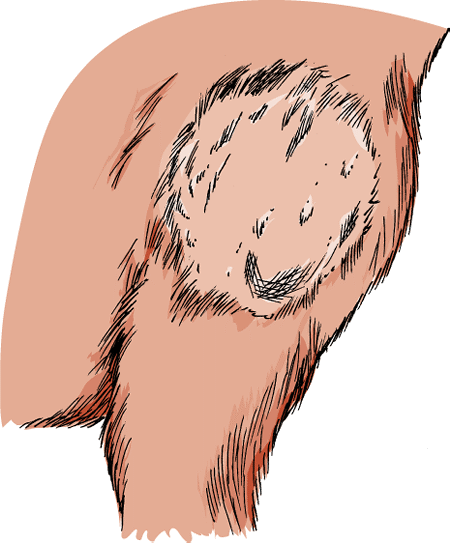Ringworm (Dermatophytosis) in Dogs
- Skin Disorders of Dogs
- Structure of the Skin in Dogs
- Dermatitis and Dermatologic Problems in Dogs
- Diagnosis of Skin Disorders in Dogs
- Treatment of Skin Disorders in Dogs
- Congenital and Inherited Skin Disorders in Dogs
- Allergies in Dogs
- Abscesses Between the Toes (Interdigital Furunculosis) in Dogs
- Contagious Ecthyma (Orf, Contagious Pustular Dermatitis, Sore Mouth) in Dogs
- Dermatophilosis in Dogs
- Eosinophilic Granuloma Complex in Dogs
- Fleas of Dogs
- Flies and Mosquitoes of Dogs
- Hair Loss (Alopecia) in Dogs
- Hives and Rashes (Urticaria) in Dogs
- Hygroma in Dogs
- Hyperpigmentation in Dogs
- Itching (Pruritus) in Dogs
- Lice of Dogs
- Mite Infestation (Mange, Acariasis, Scabies) in Dogs
- Nasal Dermatoses in Dogs
- Parasitic Worms of the Skin in Dogs
- Photosensitization in Dogs
- Pyoderma in Dogs
- Ringworm (Dermatophytosis) in Dogs
- Seborrhea in Dogs
- Ticks of Dogs
- Tumors of the Skin in Dogs
- Whole-body Disorders that Affect the Skin in Dogs
Also see professional content regarding ringworm in dogs.
Ringworm is an infection of skin, hair, or claws caused by a type of fungus. In dogs, about 70% of ringworm cases are caused by the fungus Microsporum canis, 20% by Microsporum gypseum, and 10% by Trichophyton mentagrophytes. The infecting fungus is spread easily in the environment. People can easily be infected with these fungi.
Most cases of ringworm are spread by contact with infected animals or contaminated objects such as furniture or grooming tools. Broken hairs with associated spores are important sources for spread of the disease. Contact does not always result in infection. Whether infection is established depends on the fungal species and on host factors, including age, health, condition of exposed skin surfaces, grooming behavior, and nutrition. Infection leads to short-lived resistance to reinfection. Under most circumstances, dermatophytes grow only in the dead cells of skin and hair, and infection stops on reaching living cells or inflamed tissue. As inflammation and host immunity develop, further spread of infection stops, but this process may take several weeks.
Infected dogs develop bald, scaly patches with broken hairs in ring-like whirls. The most common sites affected by ringworm are the face, ear tips, tail, and feet. Ringworm is diagnosed by fungal culture, examination with an ultraviolet lamp, and direct microscopic examination of hair or skin scale. Fungal culture of hairs and scrapings from the affected areas is the most accurate method. Direct microscopic examination of hairs or skin scrapings may allow early diagnosis.
Ringworm infections usually clear up without treatment, but medicated shampoos might speed recovery in some cases. Such treatments are not always effective, however. Your veterinarian can provide you with information about any treatment that may be appropriate for your pet and advise you regarding precautions you should take to avoid ringworm infection in yourself and members of your family.
For More Information
Also see professional content regarding ringworm in dogs.
Resources In This Article
- Skin Disorders of Dogs
- Structure of the Skin in Dogs
- Dermatitis and Dermatologic Problems in Dogs
- Diagnosis of Skin Disorders in Dogs
- Treatment of Skin Disorders in Dogs
- Congenital and Inherited Skin Disorders in Dogs
- Allergies in Dogs
- Abscesses Between the Toes (Interdigital Furunculosis) in Dogs
- Contagious Ecthyma (Orf, Contagious Pustular Dermatitis, Sore Mouth) in Dogs
- Dermatophilosis in Dogs
- Eosinophilic Granuloma Complex in Dogs
- Fleas of Dogs
- Flies and Mosquitoes of Dogs
- Hair Loss (Alopecia) in Dogs
- Hives and Rashes (Urticaria) in Dogs
- Hygroma in Dogs
- Hyperpigmentation in Dogs
- Itching (Pruritus) in Dogs
- Lice of Dogs
- Mite Infestation (Mange, Acariasis, Scabies) in Dogs
- Nasal Dermatoses in Dogs
- Parasitic Worms of the Skin in Dogs
- Photosensitization in Dogs
- Pyoderma in Dogs
- Ringworm (Dermatophytosis) in Dogs
- Seborrhea in Dogs
- Ticks of Dogs
- Tumors of the Skin in Dogs
- Whole-body Disorders that Affect the Skin in Dogs






